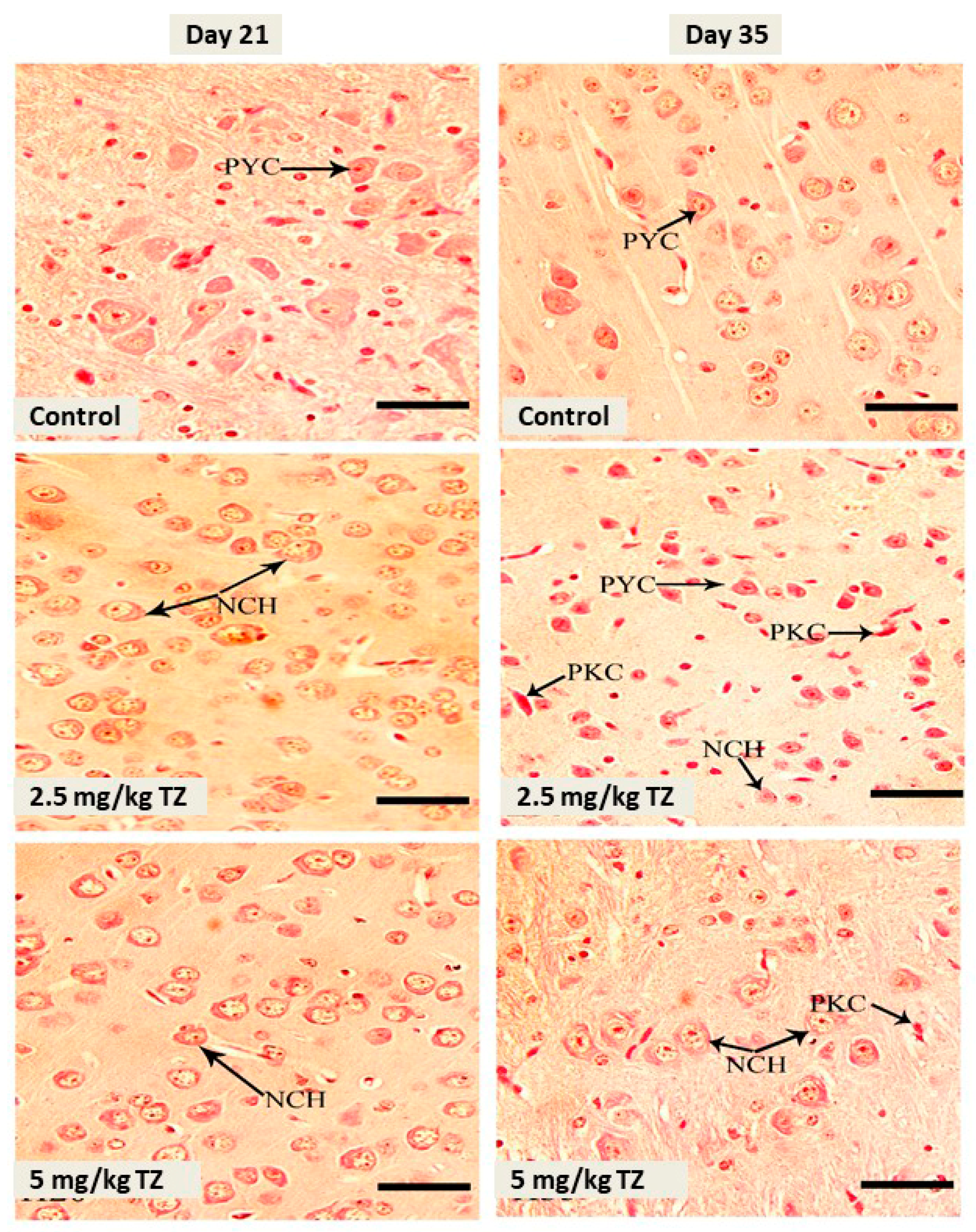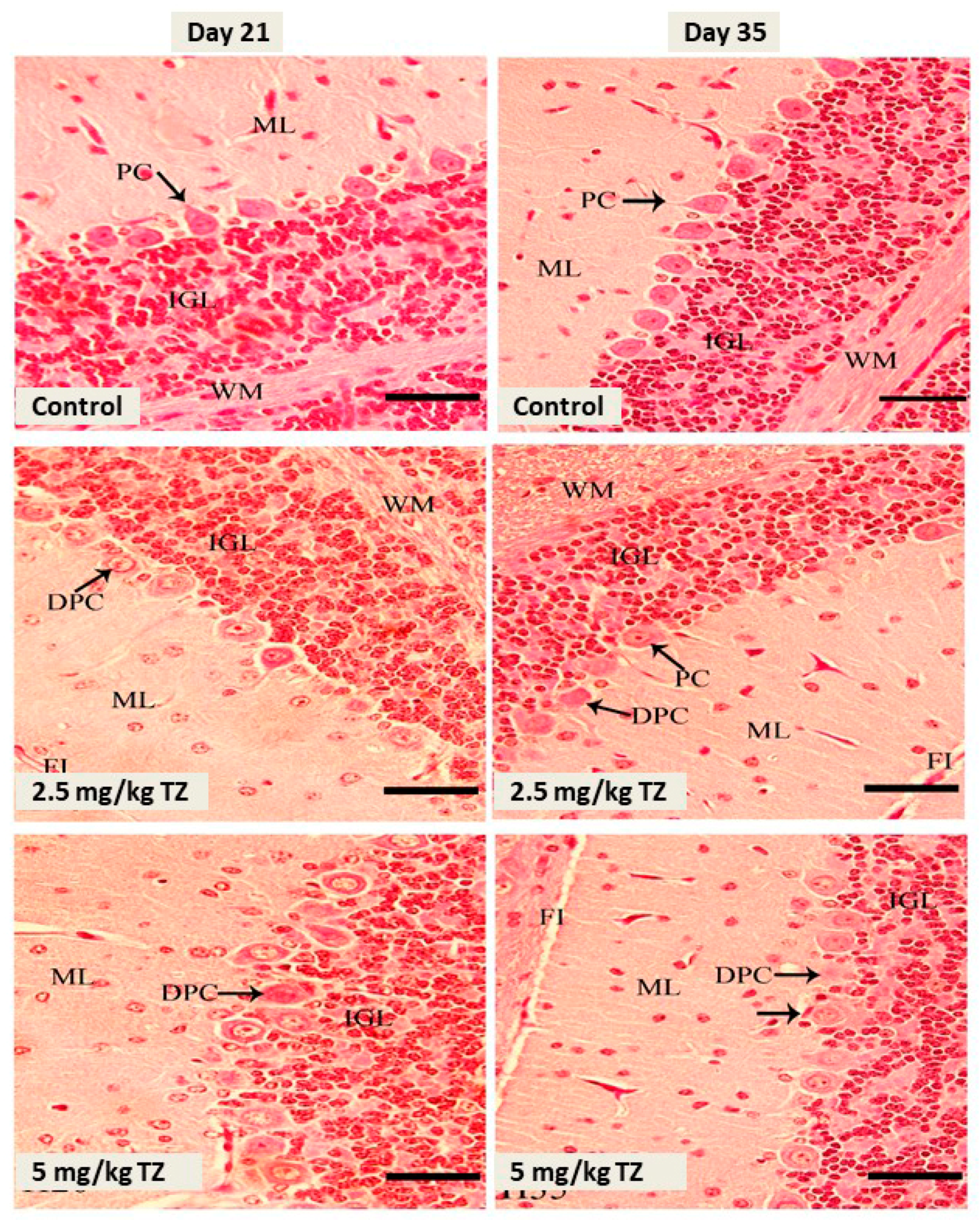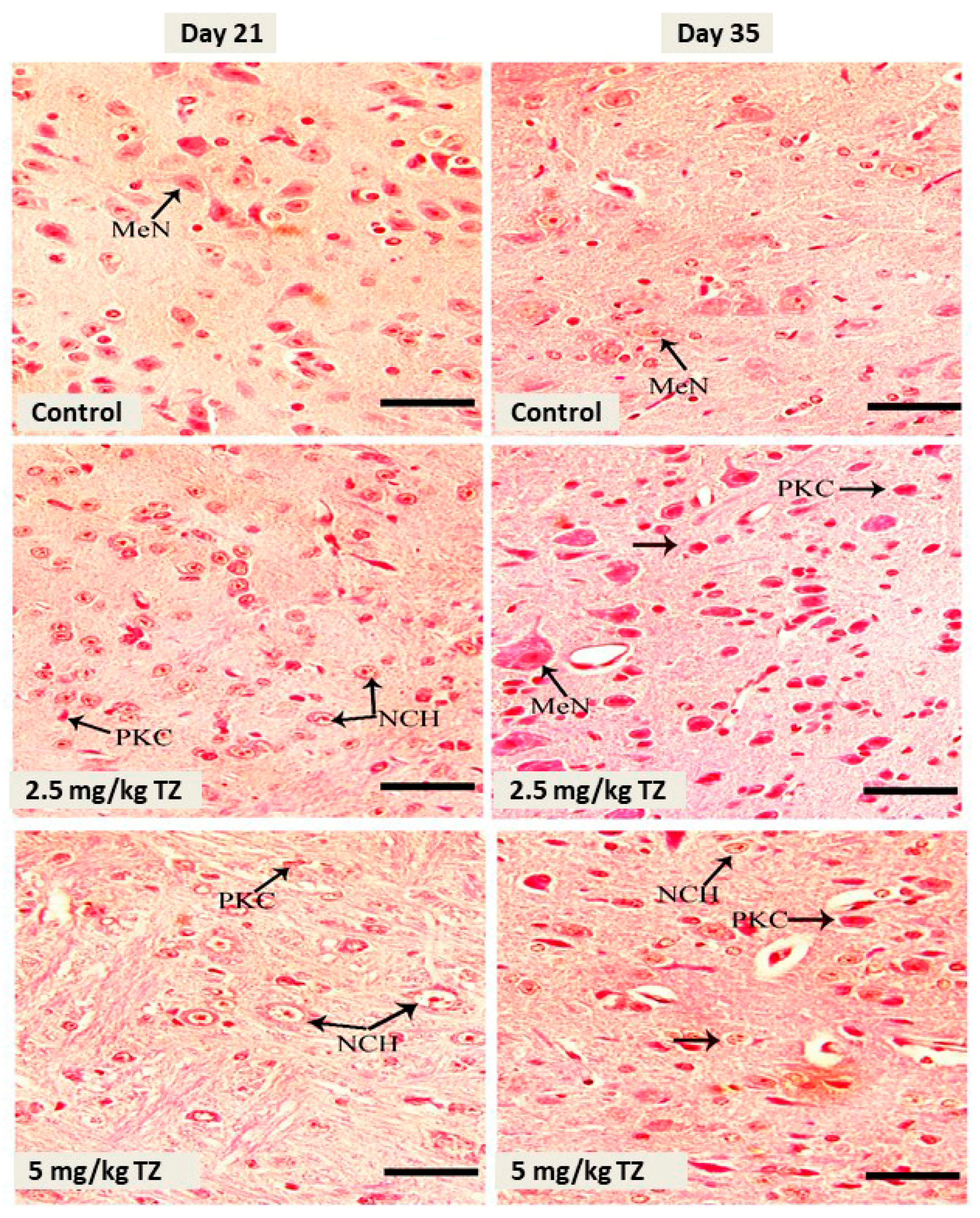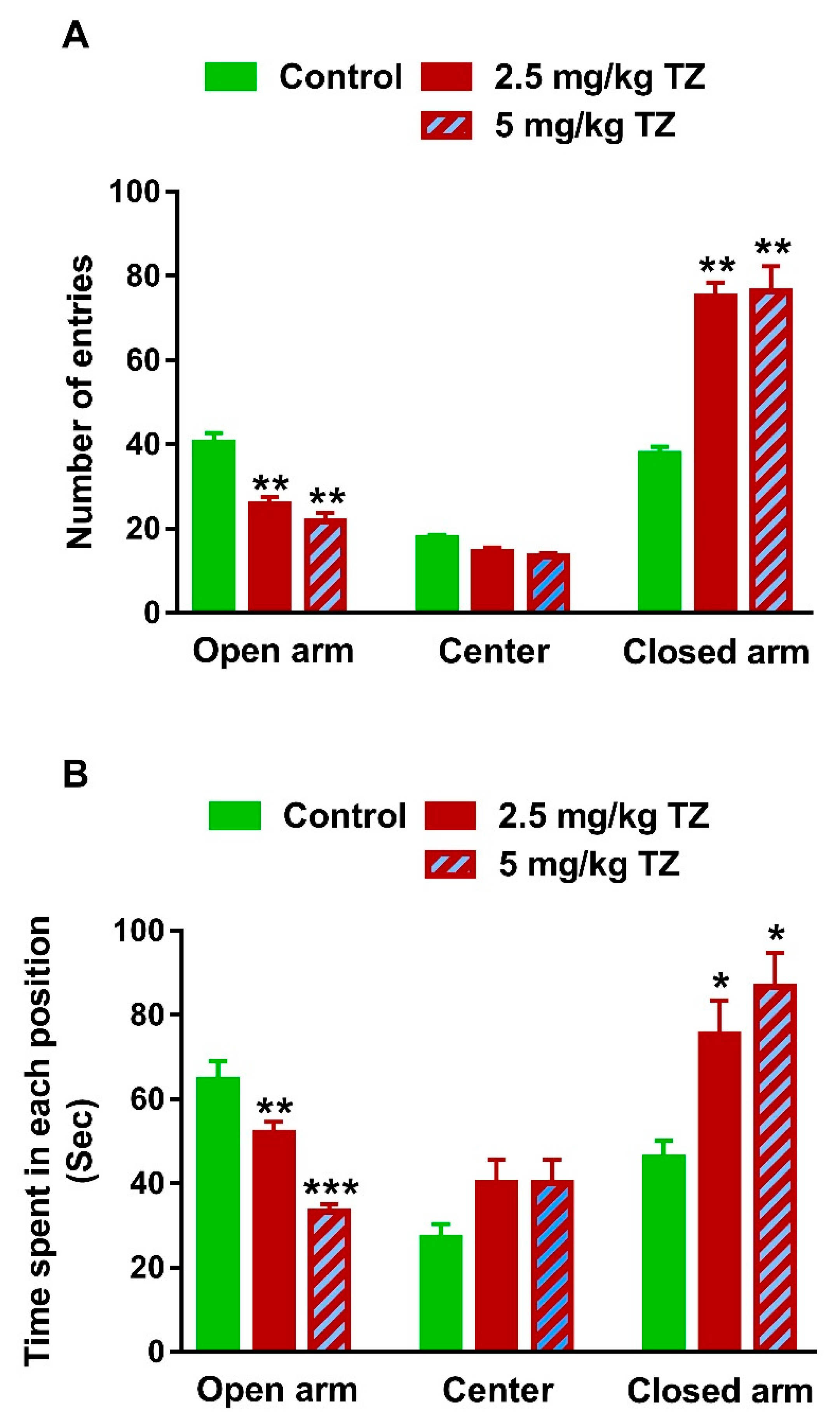Perinatal Exposure to Tartrazine Triggers Oxidative Stress and Neurobehavioral Alterations in Mice Offspring
Abstract
1. Introduction
2. Materials and Methods
2.1. Experimental Design
2.2. Behavioral Study
2.2.1. Locomotor Behavior
2.2.2. Fear and Anxiety Reflex
2.3. Determination of Malondialdehyde (MDA) and Antioxidants
2.4. Histological Investigation
2.5. Determination of Hematological Parameters
2.6. Statistical Analysis
3. Results
3.1. Effect of TZ on the Histology of Cerebrum, Cerebellum, and Medulla Oblongata
3.2. TZ Induces Anxiety-Like Behavior in Newborns
3.3. Effect of TZ on the Locomotion Behavior in Newborn Mice
3.4. TZ Induces LPO and Suppresses Antioxidants in the Brain of Newborn Mice
3.5. TZ Alters Hematological Parameters in Newborn Mice
4. Discussion
5. Conclusions
Author Contributions
Funding
Acknowledgments
Conflicts of Interest
References
- Leo, L.; Loong, C.; Ho, X.L.; Raman, M.F.B.; Suan, M.Y.T.; Loke, W.M. Occurrence of azo food dyes and their effects on cellular inflammatory responses. Nutrition 2018, 46, 36–40. [Google Scholar] [CrossRef] [PubMed]
- Revankar, M.S.; Lele, S.S. Synthetic dye decolorization by white rot fungus, Ganoderma sp. Wr-1. Bioresour. Technol. 2007, 98, 775–780. [Google Scholar] [CrossRef] [PubMed]
- Alsalman, N.; Aljafari, A.; Wani, T.A.; Zargar, S. High-dose aspirin reverses tartrazine-induced cell growth dysregulation independent of p53 signaling and antioxidant mechanisms in rat brain. Biomed. Res. Int. 2019, 2019, 9096404. [Google Scholar] [CrossRef] [PubMed]
- El-Desoky, G.E.; Abdel-Ghaffar, A.; Al-Othman, Z.A.; Habila, M.A.; Al-Sheikh, Y.A.; Ghneim, H.K.; Giesy, J.P.; Aboul-Soud, M.A. Curcumin protects against tartrazine-mediated oxidative stress and hepatotoxicity in male rats. Eur. Rev. Med. Pharm. Sci. 2017, 21, 635–645. [Google Scholar]
- Meyer, S.K.; Probert, P.M.E.; Lakey, A.F.; Axon, A.R.; Leitch, A.C.; Williams, F.M.; Jowsey, P.A.; Blain, P.G.; Kass, G.E.N.; Wright, M.C. Hepatic effects of tartrazine (e 102) after systemic exposure are independent of oestrogen receptor interactions in the mouse. Toxicol. Lett. 2017, 273, 55–68. [Google Scholar] [CrossRef]
- Amin, K.A.; Abdel Hameid, H., 2nd; Abd Elsttar, A.H. Effect of food azo dyes tartrazine and carmoisine on biochemical parameters related to renal, hepatic function and oxidative stress biomarkers in young male rats. Food Chem. Toxicol. 2010, 48, 2994–2999. [Google Scholar] [CrossRef]
- Moutinho, I.L.; Bertges, L.C.; Assis, R.V. Prolonged use of the food dye tartrazine (fd&c yellow no 5) and its effects on the gastric mucosa of wistar rats. Braz. J. Biol. 2007, 67, 141–145. [Google Scholar]
- Chung, K.T. Mutagenicity and carcinogenicity of aromatic amines metabolically produced from azo dyes. J. Environ. Sci. Health Part C Environ. Carcinog. Ecotoxicol. Rev. 2000, 18, 51–74. [Google Scholar] [CrossRef]
- Walton, K.; Walker, R.; van de Sandt, J.J.; Castell, J.V.; Knapp, A.G.; Kozianowski, G.; Roberfroid, M.; Schilter, B. The application of in vitro data in the derivation of the acceptable daily intake of food additives. Food Chem. Toxicol. Int. J. Publ. Br. Ind. Biol. Res. Assoc. 1999, 37, 1175–1197. [Google Scholar] [CrossRef]
- Mohamed, A.A.; Galal, A.A.; Elewa, Y.H. Comparative protective effects of royal jelly and cod liver oil against neurotoxic impact of tartrazine on male rat pups brain. Acta Histochem. 2015, 117, 649–658. [Google Scholar] [CrossRef]
- EFSA Panel on Food Additives and Nutrient Sources added to Food. Scientific opinion on the re-evaluation tartrazine (E 102) on request from the European Commission. Efsa J. 2009, 7, 1331. [Google Scholar] [CrossRef]
- Gao, Y.; Li, C.; Shen, J.; Yin, H.; An, X.; Jin, H. Effect of food azo dye tartrazine on learning and memory functions in mice and rats, and the possible mechanisms involved. J. Food Sci. 2011, 76, T125–T129. [Google Scholar] [CrossRef]
- McCann, D.; Barrett, A.; Cooper, A.; Crumpler, D.; Dalen, L.; Grimshaw, K.; Kitchin, E.; Lok, K.; Porteous, L.; Prince, E.; et al. Food additives and hyperactive behaviour in 3-year-old and 8/9-year-old children in the community: A randomised, double-blinded, placebo-controlled trial. Lancet (Lond. Engl.) 2007, 370, 1560–1567. [Google Scholar] [CrossRef]
- Hashem, M.M.; Abd-Elhakim, Y.M.; Abo-El-Sooud, K.; Eleiwa, M.M.E. Embryotoxic and teratogenic effects of tartrazine in rats. Toxicol. Res. 2019, 35, 75–81. [Google Scholar] [CrossRef] [PubMed]
- Sobotka, T.J.; Brodie, R.E.; Spaid, S.L. Tartrazine and the developing nervous system of rats. J. Toxicol. Environ. Health 1977, 2, 1211–1220. [Google Scholar] [CrossRef] [PubMed]
- Ajarem, J.S.; Ahmad, M. Prenatal nicotine exposure modifies behavior of mice through early development. Pharmacol. Biochem. Behav. 1998, 59, 313–318. [Google Scholar] [CrossRef]
- Abu-Taweel, G.M. Effects of perinatal exposure of lithium on neuro-behaviour of developing mice offspring. Indian J. Exp. Biol. 2012, 50, 696–701. [Google Scholar]
- Ohkawa, H.; Ohishi, N.; Yagi, K. Assay for lipid peroxides in animal tissues by thiobarbituric acid reaction. Anal. Biochem. 1979, 95, 351–358. [Google Scholar] [CrossRef]
- Ellman, G.L. Tissue sulfhydryl groups. Arch. Biochem. Biophys. 1959, 82, 70–77. [Google Scholar] [CrossRef]
- Sun, Y.; Oberley, L.W.; Li, Y. A simple method for clinical assay of superoxide dismutase. Clin. Chem. 1988, 34, 497–500. [Google Scholar]
- Wall, P.M.; Messier, C. Methodological and conceptual issues in the use of the elevated plus-maze as a psychological measurement instrument of animal anxiety-like behavior. Neurosci. Biobehav. Rev. 2001, 25, 275–286. [Google Scholar] [CrossRef]
- Bhatt, D.; Vyas, K.; Singh, S.; John, P.J.; Soni, I. Tartrazine induced neurobiochemical alterations in rat brain sub-regions. Food Chem. Toxicol. Int. J. Publ. Br. Ind. Biol. Res. Assoc. 2018, 113, 322–327. [Google Scholar] [CrossRef] [PubMed]
- Ishidate, M., Jr.; Sofuni, T.; Yoshikawa, K.; Hayashi, M.; Nohmi, T.; Sawada, M.; Matsuoka, A. Primary mutagenicity screening of food additives currently used in japan. Food Chem. Toxicol. Int. J. Publ. Br. Ind. Biol. Res. Assoc. 1984, 22, 623–636. [Google Scholar] [CrossRef]
- Goldenring, J.R.; Batter, D.K.; Shaywitz, B.A. Sulfanilic acid: Behavioral change related to azo food dyes in developing rats. Neurobehav. Toxicol. Teratol. 1982, 4, 43–49. [Google Scholar] [PubMed]
- Cerniglia, C.E.; Zhuo, Z.; Manning, B.W.; Federle, T.W.; Heflich, R.H. Mutagenic activation of the benzidine-based dye direct black 38 by human intestinal microflora. Mutat. Res. 1986, 175, 11–16. [Google Scholar] [CrossRef]
- Sweeney, E.A.; Chipman, J.K.; Forsythe, S.J. Evidence for direct-acting oxidative genotoxicity by reduction products of azo dyes. Environ. Health Perspect. 1994, 102, 119–122. [Google Scholar]
- Al-Basher, G.I.; Aljabal, H.; Almeer, R.S.; Allam, A.A.; Mahmoud, A.M. Perinatal exposure to energy drink induces oxidative damage in the liver, kidney and brain, and behavioral alterations in mice offspring. Biomed. Pharmacother. 2018, 102, 798–811. [Google Scholar] [CrossRef]
- Ajarem, J.S.; Al-Basher, G.; Allam, A.A.; Mahmoud, A.M. Camellia sinensis prevents perinatal nicotine-induced neurobehavioral alterations, tissue injury, and oxidative stress in male and female mice newborns. Oxid. Med. Cell. Longev. 2017, 2017, 5985219. [Google Scholar] [CrossRef]
- Bouayed, J.; Rammal, H.; Soulimani, R. Oxidative stress and anxiety: Relationship and cellular pathways. Oxid. Med. Cell. Longev. 2009, 2, 63–67. [Google Scholar] [CrossRef]
- Pierce, R.C.; Kalivas, P.W. Locomotor behavior. Curr. Protoc. Neurosci. 2007. [Google Scholar] [CrossRef]
- Mahmoud, A.M.; Alqahtani, S.; Othman, S.I.; Germoush, M.O.; Hussein, O.E.; Al-Basher, G.; Khim, J.S.; Al-Qaraawi, M.A.; Al-Harbi, H.M.; Fadel, A.; et al. Commiphora molmol modulates glutamate-nitric oxide-cgmp and nrf2/are/ho-1 pathways and attenuates oxidative stress and hematological alterations in hyperammonemic rats. Oxid. Med. Cell. Longev. 2017, 2017, 7369671. [Google Scholar] [CrossRef] [PubMed]
- Alqahtani, S.; Mahmoud, A.M. Gamma-glutamylcysteine ethyl ester protects against cyclophosphamide-induced liver injury and hematologic alterations via upregulation of ppargamma and attenuation of oxidative stress, inflammation, and apoptosis. Oxid. Med. Cell. Longev. 2016, 2016, 4016209. [Google Scholar] [CrossRef] [PubMed]
- Ranneh, Y.; Akim, A.M.; Hamid, H.A.; Khazaai, H.; Fadel, A.; Mahmoud, A.M. Stingless bee honey protects against lipopolysaccharide induced-chronic subclinical systemic inflammation and oxidative stress by modulating nrf2, nf-kappab and p38 mapk. Nutr. Metab. 2019, 16, 15. [Google Scholar] [CrossRef] [PubMed]
- Al-Basher, G.; Al-Motiri, H.; Al-Farraj, S.; Al-Otibi, F.; Al-Sultan, N.; Al-Kubaisi, N.; Al-Sarar, D.; Al-Dosary, M.; Bin-Jumah, M.; Mahmoud, A.M. Chronic exposure to 35% carbamide peroxide tooth bleaching agent induces histological and hematological alterations, oxidative stress, and inflammation in mice. Environ. Sci. Pollut. Res. Int. 2019, 26, 17427–17437. [Google Scholar] [CrossRef] [PubMed]
- Mahmoud, A.M. Hematological alterations in diabetic rats—Role of adipocytokines and effect of citrus flavonoids. EXCLI J. 2013, 12, 647–657. [Google Scholar]
- Elbanna, K.; Sarhan, O.M.; Khider, M.; Elmogy, M.; Abulreesh, H.H.; Shaaban, M.R. Microbiological, histological, and biochemical evidence for the adverse effects of food azo dyes on rats. J. Food Drug Anal. 2017, 25, 667–680. [Google Scholar] [CrossRef]
- Reza, M.S.A.; Hasan, M.M.; Kamruzzaman, M.; Hossain, M.I.; Zubair, M.A.; Bari, L.; Abedin, M.Z.; Reza, M.A.; Khalid-Bin-Ferdaus, K.M.; Haque, K.M.F.; et al. Study of a common azo food dye in mice model: Toxicity reports and its relation to carcinogenicity. Food Sci. Nutr. 2019, 7, 667–677. [Google Scholar] [CrossRef]
- Nurden, A.T. Platelets, inflammation and tissue regeneration. Thromb. Haemost. 2011, 10, S13–S33. [Google Scholar] [CrossRef]







© 2020 by the authors. Licensee MDPI, Basel, Switzerland. This article is an open access article distributed under the terms and conditions of the Creative Commons Attribution (CC BY) license (http://creativecommons.org/licenses/by/4.0/).
Share and Cite
Albasher, G.; Maashi, N.; Alfarraj, S.; Almeer, R.; Albrahim, T.; Alotibi, F.; Bin-Jumah, M.; Mahmoud, A.M. Perinatal Exposure to Tartrazine Triggers Oxidative Stress and Neurobehavioral Alterations in Mice Offspring. Antioxidants 2020, 9, 53. https://doi.org/10.3390/antiox9010053
Albasher G, Maashi N, Alfarraj S, Almeer R, Albrahim T, Alotibi F, Bin-Jumah M, Mahmoud AM. Perinatal Exposure to Tartrazine Triggers Oxidative Stress and Neurobehavioral Alterations in Mice Offspring. Antioxidants. 2020; 9(1):53. https://doi.org/10.3390/antiox9010053
Chicago/Turabian StyleAlbasher, Gadah, Najla Maashi, Saleh Alfarraj, Rafa Almeer, Tarfa Albrahim, Fatimah Alotibi, May Bin-Jumah, and Ayman M. Mahmoud. 2020. "Perinatal Exposure to Tartrazine Triggers Oxidative Stress and Neurobehavioral Alterations in Mice Offspring" Antioxidants 9, no. 1: 53. https://doi.org/10.3390/antiox9010053
APA StyleAlbasher, G., Maashi, N., Alfarraj, S., Almeer, R., Albrahim, T., Alotibi, F., Bin-Jumah, M., & Mahmoud, A. M. (2020). Perinatal Exposure to Tartrazine Triggers Oxidative Stress and Neurobehavioral Alterations in Mice Offspring. Antioxidants, 9(1), 53. https://doi.org/10.3390/antiox9010053




